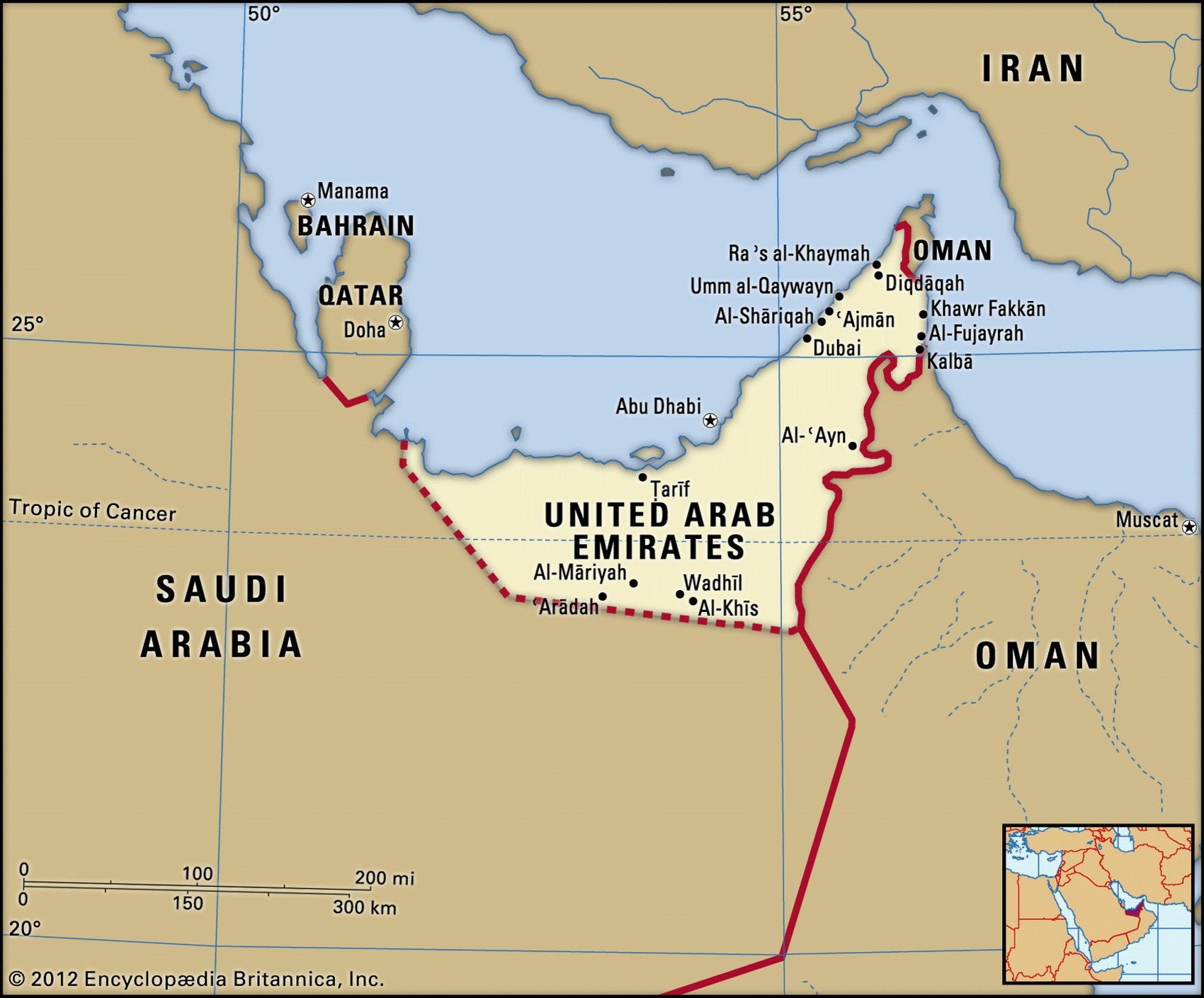Map of United Arab Emirates and geographical facts
Where United Arab Emirates is on the world map
Map of United Arab Emirates with cities. Where United Arab Emirates is on the world map. The main geographical facts about United Arab Emirates - population, country area, capital, official language, religions, industry and culture.

Fact File United Arab Emirates
Official name United Arab Emirates
Form of government Federation of Emirates with one advisory body (Federal National Council)
Capital Abu Dhabi
Area 75,581 sq km (29,182 sq miles)
Time zone GMT + 4 hours
Population 2,446,000
Projected population 2015 3,230,000
Population density 32.4 per sq km (83.8 per sq mile)
Life expectancy 74.5
Infant mortality (per 1,000) 16.1
Official language Arabic
Other languages Hindi, Urdu, Farsi (Persian), English Literacy rate 79.2 %
Religions Muslim 96% (Shi'a 16%); Christian, Hindu, other 4%
Ethnic groups Emiri 19%, other Arab and
Iranian 23%, South Asian 50%, other expatriates 8%
(only 20% of population are citizens)
Currency Emirian dirham
Economy Services 57%, industry 38%, agriculture 5%
GNP per capita US$21,100
Climate Mainly arid; cooler in eastern mountains
Highest point Jabal Yibir 1,527 m (5,010 ft)
Map reference Pages 220-21
People in the seven small principalities that form the United Arab Emirates lived for centuries as seagoing traders on the shores of the Persian Gulf. When piracy became a nuisance in 1820, Britain entered into truces with the local emirs to end attacks on shipping, and established a protectorate in the region. Soon the principalities were known as the Trucial States. In 1971 they became independent and formed the federation of sheikdoms now known as the United Arab Emirates (UAE). They are situated along the southern coast of the Persian Gulf between the Qatar Peninsula to the west and the Straits of Hormuz, and share borders with Qatar, Saudi Arabia, and Oman.
Abu Zaby (Abu Dhabi) is more than six times the size of all the other states put together, has the biggest population, and is the main oil producer. In the form of federal funds, it contributes to development projects in the poorer states. The port in Dubayy (Dubai) is one of the world's largest maritime facilities, and has attracted companies from 58 countries active in the petroleum industry, trading, and financial services. A major economic contribution has been made by expatriates who flocked to the country during the 1970s' oil boom—only twenty percent of UAE citizens are native born. Whether this workforce can now be 'Emiratized' is a concern, as is the growth of Islamic fundamentalism among the young. In world affairs the UAE is a force for moderation in the Arab world. It maintains close links with the UK and USA.
The Gulf coast features saline marshes merging inland with barren desert plains. In the east there is a range of steep mountains. These are an extension of Oman's Hajar Mountains, running northward along the Musandam Peninsula. The sheikhdom of Al Fujayrah looks out from this peninsula onto the Gulf of Oman, and contains the only highland expanse. Less than 1.2 percent of UAE land is arable, and most vegetation is sparse and scrubby. Virtually all agricultural activity is found in the emirates of Sharjah, Ras al Khaimana, Ajman, and Fujairah, where oasis date palms grow. Government incentives, however, plus irrigation works, have increased the number of farmers fourfold in recent years. While much food is imported, self-sufficiency in wheat is still a target.
Once an impoverished region of small desert sheikhdoms, the UAE has since 1973 been transformed into a modern state with a high standard of living. Oil and gas production is the largest economic sector, accounting for 89 percent of export revenue. Though in the short term the fortunes of the economy fluctuate with the price of gas and oil, at the present level of production oil reserves should last more than 100 years. Increased privatization is being encouraged by the government, and service industries are being developed. Although the UAE is much stronger economically than most of the Gulf States, a number of weaknesses remain. While the largest solar-powered water-production plant in the Gulf region is at Taweela, industrial development is likely to be limited by the fact that water will always be in short supply. There is a lack of skilled labor. Most raw materials and foodstuffs have to be imported.